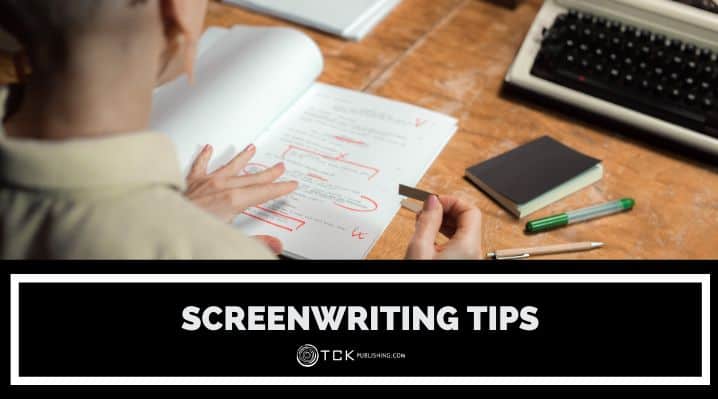
Seeing your story unfold on a screen is an incredible dream. But screenwriting is a whole different beast compared to writing novels. What’s the difference? And how will it affect your writing strategy?
How Screenwriting Differs from Other Writing
Different formats, mediums, and audiences require different writing styles. Here are just a few ways that screenwriting is distinct from other types of writing.
Versus Novels
When writing a novel, you can dive into a character’s thoughts, paint vivid descriptions, and explore backstories. Screenwriting, however, relies on visuals and dialogue to tell the story.
For example, in a novel, you might write:
- Tears streamed down her face as she clutched at a picture frame. He was gone—and she was still here.
In a screenplay, you’d show the heartbreak visually:
- INT. BEDROOM – NIGHT
She sits on the bed, holding a photograph. Her hands tremble. A tear drops onto the picture frame.
Versus Radio
Radio scripts rely entirely on sound—dialogue, music, and effects. Screenwriting takes things further by combining audio with visuals.
For instance, a suspenseful moment in radio might depend on eerie sound effects. On screen, you’d use dim lighting and a character’s terrified, panicked expression.
Versus Plays
Plays are written for live performances, usually happening in real time and within one scene. Playwrights must also consider the stage’s physical limitations when writing.
Screenplays have the freedom to manipulate scenes through editing and camera techniques.
Imagine a breakup scene:
- In a play, a couple would argue in a single room. Any scene changes will need set transitions.
- In a screenplay, the argument could cut between flashbacks, close-ups, and even silence.
Actionable Tips For Screenwriting
Keep these tips in mind the next time you write a draft.
Learn the format.
Screenwriting has strict formatting rules. Think Courier font, specific margins, and layout for action, dialogue, and scene headings.
Learning this format is crucial—it’s the first sign you’re serious about screenwriting. Fortunately, there are screenwriting software like Celtx and Final Draft that make this easier.
Create an outline.
An outline is a guide. It helps you figure out what the story is, what’s best for it, and how you get it from start to finish.
It can be as short or long as you want. Some writers do well with only bullet points, others need a more detailed approach. Each is fine! What’s important is you make a road map that keeps you true to the story while writing it.
Focus on visual storytelling.
The audience won’t be privy to a character’s inner thoughts—unless a narrator spills them. Show emotions and actions visually. Instead of explaining everything in dialogue, let the audience see what’s happening.
Bad:
- “I’m so angry at you!” she yelled.
Better:
- She slammed the door shut on his face.
Keep dialogue short and sharp.
Less is more. Think about how people speak in real life—rarely do they deliver long speeches.
Example:
In Jaws, “You’re gonna need a bigger boat” conveys fear, urgency, and humor all at once. No need for extra words!
Start with the three-act structure.
The three-act structure is a tried-and-true template in storytelling. It’s simple and provides a foundation for your narrative.
- Act 1: Set up the characters and conflict.
- Act 2: Raise the stakes.
- Act 3: Resolve the story.
Example: The Dark Knight
- Act 1: The Joker arrives and causes chaos.
- Act 2: Harvey Dent falls.
- Act 3: Batman makes the ultimate sacrifice.
Of course, the movie is more complicated than that. The three-act structure is simply a starting point. It gives you space to focus on other story elements. The better you master it, the more you can explore and break the mold.
Invest in your characters.
Bad characters ruin good plots and vice versa. Give your characters clear goals, flaws, and growth. Make them characters your audience will connect with emotionally—whether those emotions are positive or negative.
Take Tony Stark, for example. He begins as selfish and arrogant but evolves into a selfless hero. But he doesn’t turn into a completely different person. His arrogance is still there but is now grounded by a sense of duty and sacrifice.
Create character sheets. There are plenty of formats online, but you can easily make your own.
The more you know your characters, the better you’ll write them. Approach them from an interviewer’s mindset. What questions should you ask to get to know them better?
Raise the stakes.
A great story is one with consequences. Something must happen if your protagonist fails. The more they need to struggle for their goals, the more cathartic their victory becomes.
The initial conflict kick-starts the story. Raising the stakes means the story is at a point of no return. It’s all or nothing for the protagonist.
That drama is what keeps the story going, and the audience invested. Ask yourself, what’s the worst thing that could happen at this point in the story?
Finish what you started.
You’ve hit act two, and now you’re lost. There’s a lot to fix and you don’t like how the story will end. So you abandon your manuscript.
Don’t. See it through. A bad draft is better than no draft at all. Learn from it and do better on the next one. Quitting halfway through to restart won’t teach you what’s wrong with the draft in the first place.
Read other screenplays.
Learning from other writers is arguably the best advice for any writer. See what they’re doing right, how they’ve evolved, and how they approach the craft.
Look at how your favorite movies and TV shows are written. Get technical when analyzing them. How are the scenes arranged? In what order are the characters introduced? What techniques did they use?
Their success is a good barometer for what works. The more recent ones are proof of what’s currently popular.
Conclusion
Screenwriting isn’t easy, but it’s one of the most rewarding forms of storytelling. Seeing your story come alive on screen is an unforgettable experience.
A screenplay serves as the blueprint for an entire production. Every scene, line, and transition must have a clear purpose, leaving room for other creatives—directors, actors, and cinematographers—to bring their expertise to the table.
It’s a challenging process, but one worth taking. Whether your script becomes a blockbuster or an unproduced gem, the process will deepen your appreciation for visual storytelling.
What other screenwriting tips do you have? Share your thoughts below!
If you enjoyed this post, then you might also like:
- How to Get a Job Writing for TV
- Save the Cat Beat Sheet: A Quick Guide
- TaleFlick Review: Pay and Wait for Your Story to Be Optioned

Cole is a blog writer and aspiring novelist. He has a degree in Communications and is an advocate of media and information literacy and responsible media practices. Aside from his interest in technology, crafts, and food, he’s also your typical science fiction and fantasy junkie, spending most of his free time reading through an ever-growing to-be-read list. It’s either that or procrastinating over actually writing his book. Wish him luck!
